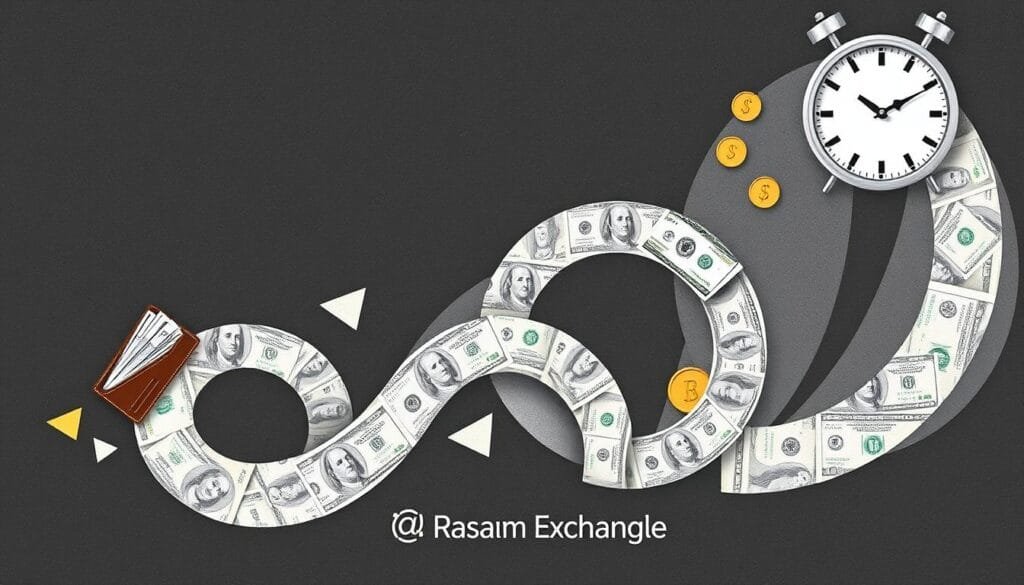Planning for retirement means more than just saving money. It’s about making smart choices to secure your financial future. This article will show you how to plan for a good retirement. You’ll learn about the FIRE movement, breaking the paycheck cycle, and building a strong savings.
It will also cover managing debt, the role of an emergency fund, and keeping up with financial habits. These steps will help you take charge of your money and live comfortably in retirement.
Key Takeaways
- Develop a comprehensive retirement planning strategy that includes investment portfolio diversification, tax-efficient savings, and passive income streams.
- Understand the importance of healthcare costs and estate planning in retirement planning.
- Maximize retirement account contributions, such as 401(k) and IRA, to take advantage of tax benefits.
- Explore the benefits of currency exchange and international investments to enhance your financial independence.
- Prioritize building a strong emergency fund to provide financial stability and flexibility.
What is the FIRE Movement?
The FIRE (Financial Independence, Retire Early) movement is all about getting financially independent and retiring early. It’s about saving a lot and investing wisely to hit a certain “FIRE number.” This number is usually 25 times your yearly expenses. It’s the key to early retirement or more financial freedom.
Understanding FIRE: Financial Independence, Retire Early
The FIRE movement has different ways to reach your financial goals. These include:
- Fat FIRE: Saving a lot while still living comfortably in retirement.
- Lean FIRE: Living simply to save faster and reach financial independence sooner.
- Barista FIRE: Working part-time and saving to support your retirement lifestyle.
The Purpose and Variations of FIRE
The FIRE movement helps people take charge of their money. It aims for financial independence, letting you work on your terms or retire early. Knowing the different FIRE styles helps match your financial plans with your life goals.

“The FIRE movement encourages individuals to invest 15% of their income into tax-advantaged retirement accounts like 401(k)s and Roth IRAs.”
Break the Paycheck-to-Paycheck Cycle
Are you tired of living paycheck-to-paycheck, always worrying about money? You’re not alone. Over 78% of Americans feel trapped in this cycle. But, there are steps to help you break free and take control of your money.
Reducing Expenses and Creating Additional Income Streams
To break the cycle, focus on two things: cut expenses and make more money. First, look at where you spend money and see where you can save. Cutting back on things like eating out or entertainment can help a lot.
Then, find ways to make more money. Think about getting a part-time job, freelancing, or starting a side business. There are many options, like ridesharing or online tutoring, to earn extra cash and improve your finances.
| Expense Reduction Strategies | Additional Income Opportunities |
|---|---|
|
|
Remember, having a strong reason for your efforts is key. Stay motivated by focusing on your financial goals. This will help you make the changes needed for a better financial future.
“The best way to predict the future is to create it.” – Peter Drucker
Breaking the paycheck-to-paycheck cycle improves your finances now and sets you up for long-term independence. This means you can chase your dreams without financial worries.

Building Your Nest Egg
Building a strong nest egg is key to financial freedom and a good retirement. It means putting money into retirement accounts like 401(k)s and IRAs. This takes advantage of tax-efficient savings and compound interest. Also, spreading your investment portfolio across different types of investments helps lower risk and increase growth.
Starting to save in your 20s can lead to more wealth by retirement than starting in your 30s or 40s, even with bigger contributions later. The 4% Rule says you can take out 4% of your portfolio in the first year and adjust for inflation later. This can make your savings last 30 years. But, the right withdrawal rate depends on your portfolio size, expected returns, and how long you live.
Roth IRA withdrawals are tax-free, giving you control over your income in retirement. It’s important to know about taxes, as withdrawals from retirement accounts and Social Security could be taxed based on your income. Choosing cost-effective investments like index funds or ETFs can give you broad market coverage and diversification at a lower cost than actively managed funds.
Employer matches in retirement plans can really boost your nest egg by adding more money from your employer. Spreading your investments across different types of assets can lower the risk of big losses and protect your nest egg from market ups and downs. Checking and adjusting your investments regularly helps spot issues, find untapped potential, and reduce unnecessary risks for better growth of your nest egg.
Creating a big nest egg takes hard work, careful planning, and a long-term view. But, the benefits can change your financial future for the better.
Planning for Retirement: Achieve Financial Freedom
Planning for retirement means more than just saving money. It’s about making sure your money keeps working for you. This involves investing in different areas like stocks, bonds, real estate, and more. This way, you spread out your portfolio to reduce risk.
Making Your Money Work Through Investments
Using a mix of investments can help you grow your money over time. It can also create passive income to add to your retirement savings. By making smart choices, you can make sure your retirement is financially secure and enjoyable.
Diversification Strategies for Long-Term Growth
- Put your money into different types of assets, like stocks, bonds, real estate, and more.
- Focus on portfolio diversification to control risk and boost growth potential.
- Look into ways to earn passive income, such as renting out properties or investments that pay dividends.
- Check and adjust your investments often to keep them in line with your retirement planning goals and how much risk you can handle.
With a well-thought-out investment plan, you can set yourself up for long-term financial success. This way, you can live the retirement life you dream of.
Effective Debt Management Strategies
Managing debt well is key to financial freedom. Paying off high-interest debts first, like credit cards and personal loans, frees up money for savings and investments. Also, combining several debts into one with a lower interest can make paying back easier and cheaper.
Prioritizing Debt Repayment
It’s smart to pay off debts with the highest interest rates first. This method, called the “avalanche” method, saves you the most money over time by cutting down interest. Make sure to balance your budget, so you can afford to pay off debt without sacrificing savings or daily expenses.
Consolidating Debt and Budgeting Tips
Having a solid budget helps with debt management. It ensures you pay the minimum on debts and use extra money to pay off debt faster. You might also consider consolidating debts into one loan with a lower interest rate. This makes paying back easier and could lower the total interest paid.
When looking into debt consolidation, compare rates and terms to find the best deal. Make sure the new loan has a lower monthly payment and helps you pay off debt quicker. Budgeting is vital for managing debt. It helps you find ways to spend less and put more money towards debt.
“Effective debt management is a critical step towards financial independence. By prioritizing high-interest debts and exploring consolidation options, individuals can simplify the repayment process and reduce the overall cost of their debt.”
The Importance of an Emergency Fund
Creating a strong emergency fund is key to financial stability. It helps cover unexpected costs like job loss, medical bills, or big home repairs. This way, you won’t have to use your retirement savings or take on more debt.
It’s wise to save enough for three to six months of living expenses. This fund gives you financial security and peace of mind. It helps you handle sudden financial problems without hurting your overall financial health.
Studies show that those who can’t bounce back from financial shocks often have little savings. Having an emergency fund changes everything. It lets you face the unexpected with confidence and financial stability.
One good way to grow your emergency fund is by setting up automatic transfers from your checking to savings. This “pay yourself first” method makes saving easy and automatic. It becomes a regular part of your budget.
| Savings Approach | Benefit |
|---|---|
| Automatic Recurring Transfers | Makes savings a consistent and seamless habit |
| Splitting Paycheck Between Checking and Savings | Offers an automated savings option through direct deposit |
| Utilizing Tax Refunds or Windfalls | Provides a lump-sum contribution to the emergency fund |
It’s important to set clear rules for what counts as an emergency. This keeps your emergency fund safe and ensures it’s used right.
Building an emergency fund is a big step towards long-term financial health. By focusing on this, you can handle life’s surprises with ease. You’ll be free to chase your financial dreams without worrying about money.
Continuing Financial Habits for Independence
Getting financially independent is a journey, not just a one-time event. It means building and keeping good financial habits. This includes checking and tweaking your budget often, putting money into your retirement accounts, keeping up with investment opportunities, and changing your lifestyle to meet your financial goals.
Being disciplined with money is key to keeping your financial freedom journey going. Learning more about money can help you make smart choices and adjust to new financial situations.
- Regularly review and adjust your budget to ensure it aligns with your long-term planning.
- Consistently contribute to your retirement accounts, such as 401(k)s or Roth IRAs, to take advantage of the power of compound interest.
- Stay informed about various investment management strategies, including stocks, bonds, and real estate, to diversify your portfolio and maximize long-term growth.
- Make lifestyle adjustments as needed to reduce expenses and free up funds for your financial goals, such as saving for a down payment or increasing retirement contributions.
- Continuously expand your financial education through reading, attending workshops, or consulting with a financial advisor to stay informed and make well-rounded decisions.
“Financial independence is not a destination, but a way of life. It’s about developing the habits and mindset to make your money work for you, not the other way around.”
By building these financial habits, you can make sure your path to financial independence stays on track. It’s not about being perfect. It’s about learning, adapting, and moving forward step by step.
Conclusion
Planning for retirement means looking at many strategies and principles. Understanding the FIRE movement helps break free from living paycheck to paycheck. It’s about building a strong nest egg, managing debt, and keeping an emergency fund.
It’s important to keep learning and using good financial habits like budgeting and investing. These habits help on the way to financial independence. With a solid plan and discipline, you can reach financial freedom and enjoy your retirement how you want.
Getting rich and planning for retirement might seem hard, but it’s doable with the right steps. By following the advice in this article, Canadians can manage their money better. Remember, getting financially independent is a long-term effort. With the right mindset and habits, it’s possible for anyone, no matter their age or income.
